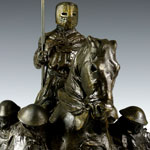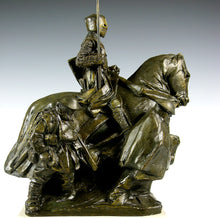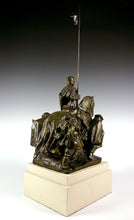The Spirit of the Crusaders
Adding product to your cart
Circa 1922
Measurements: Overall: 60cm x 18cm x 27cm (24in x 7in x 10.5in)
A bronzed plaster maquette modelled by Alice Meredith-Williams for the Great War Memorial at Paisley, Scotland.
Model excluding base: 50cm x 17cm x 27cm (20in x 6.75in x 10.5in)
The equestrian group comprises a mounted crusader flanked by four soldiers of the Great War, the latter heavily equipped for winter with heads down making determined strides against the enemy and the elements. Their stoicism tells the story of four years of continuous struggle rather than a glorious march to victory. The juxtaposition of soldiers and the central figure of the mounted knight implied shared chivalry and reinforced the idea that God was on 'our side'.
Read more
Designed in 1922, the present model was worked up for the competition of 195 entries, that was judged by the architect Sir Reginald Bloomfield (1858-1942), for the memorial to commemorate Paisley’s 1,953 war dead. Meredith-Williams, who, wrongly identified as a man in the press, also ranked third in the competition with a second entry. The final over-life size bronze group was mounted onto a twenty-five foot high granite cenotaph designed by architect Sir Robert Lorimer (1864-1929) and was formally unveiled on 27 July 1924.
Meredith-Williams' concept for the Paisley memorial links it with others around the country that sought a connection with history. However these may be seen as less ambitious. At Wrexham, for example, Sir William Goscombe John included an 18th century soldier alongside a Great War Royal Welch Fusilier to emphasize regimental tradition as did John Tweed for the Rifle Brigade in Grosvenor Gardens, London. Benjamin Clemens, on the other hand, focused on local history for the fallen of Royston, Cambridgeshire by the inclusion of the town's most famous sons. By contrast the crusader, bearing a heavenward lance with saltire pennant and sited atop the massive empty tomb, invokes the epic tale of the Scottish knights errant who in compliance with Robert the Bruce's dying wish carried his embalmed heart into battle against 'the enemies of Christ' in August 1330. Following the Battle of Teba in which some of the Scottish crusaders were killed, Muhammed IV returned their remains together with the Scottish King's heart under escort of a guard of honour. Their fellow crusaders cut out their slain friends' hearts and together with Bruce's returned them to Scotland for ritual burial.
Gertrude Alice Meredith Williams, A.R.S.B.S. (1877-1934) was born in Liverpool, the daughter of a surgeon. She studied at the School of Architecture and Applied Art in Liverpool, and at the Ecole des Beaux Arts, Paris. She worked as a sculptor, illustrator and stained glass designer and married the painter Morris Meredith Williams (1881-1973). He trained at the Slade and in 1906 was appointed art master at Fettes College. Their pre war home was in Danube Street, Edinburgh. Alice’s sculptural output during this period included decorative domestic works in terracotta, plaster, carved wood and bronze, while he produced illustrations for historically and mythologically themed books such as ‘The Northmen in Britain’ and ‘The Story of Robert the Bruce’. Such interests are clearly reflected at Paisley and indicate a level of collaboration between husband and wife. Indeed Alice's crusader bears a strong resemblance to one of Morris' book illustrations of Robert the Bruce. Following the outbreak of war, Morris volunteered and was commissioned into The Welch Regiment in April 1915. He spent the next three years on the Western Front while Alice worked in London and from a cottage studio near Henley-on-Thames during 1916-18. Her sketches made at London’s south coast railway stations of soldiers returning directly from the front in France and Flanders were quickly recognized as important contemporary documents (Imperial War Museum).
In 1927 she worked again in collaboration with Sir Robert Lorimer and her husband Morris on the Scottish National War Memorial at Edinburgh Castle. Here she created the figure of St. Michael hovering over the casket containing the names of the dead, and used Morris’s drawings of naval and military figures to model the frieze in the Shrine. These comprise Scottish soldiers, sailors, airmen, nurses in the battle dress in which they lived and died. Included too are the animal victims of war - elephants, horses, dogs, canaries used in tunnelling safety checks, and carrier pigeons. The whole was considered a masterpiece of realism by contemporaries including the 8th Duke of Atholl, one of the principal organizers of the national memorial. Referring to ‘Mrs Meredith Williams' wonderful frieze', the Duchess of Atholl stated, ‘The beauty of the frieze is in part due to her husband. During his three years in the ranks in France he made endless drawings of his fellow soldiers. The drawings furnished a priceless inspiration for the amazing number of men and women recorded in his wife's masterpiece.’
Alice was also commissioned by the Imperial War Museum to produce a sculpture of Dr Elsie Inglis in a field dressing station in Serbia, circa 1918. She worked on a number of other war memorials including a design for a Reredos for St. James the Less Episcopal Church, Penicuik, Midlothian (dedicated in May 1921), and produced the bronze group, Globe and the Winds for the naval memorial at Plymouth and a bronze panel as part of the war memorial for Queenstown, South Africa (circa 1922). With Morris she also designed the stained glass for Bermuda Cathedral. She exhibited works at the Royal Scottish Academy, the Royal Glasgow Institute, and the Royal Academy of Arts. The National Gallery of Wales and Scottish Mordern Arts were purchasers of her work - a cast bronze maquette titled ‘Spirit of the Crusades’ being in the collection of the N.M.W.
References:
Archer, G. (2009), ‘The Glorious Dead, Figurative Sculpture of British First World War Memorials’, Frontier Publishing, Norfolk
Dundee Evening Telegraph, 16.1.1922, erroneously assumed as male sculptor
Gloucestershire Echo, 7.3.1934, obituary
Gray, S. (2009) ‘The Dictionary of British Women Artists’, Lutterworth Press, Cambridge
'Gertrude Alice Meredith Williams', Mapping the Practice and Profession of Sculpture in Britain and Ireland 1851-1951, University of Glasgow History of Art and HATII, online database 2011 [http://sculpture.gla.ac.uk/view/person.php?id=msib6_1214305341, accessed 20 Oct 2014]
Western Morning News, 10.3.1934, obituary








